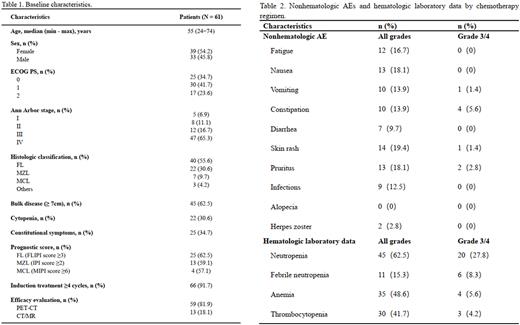Abstract
Background: Bendamustine plus rituximab (BR) was established as a preferred first line therapy for patients with previously untreated indolent non-Hodgkin's lymphoma (iNHL) and elderly MCL (eMCL) based on the BRIGHT and STiL trials. But the data is rare from Chinese patients because the unavailability of bendamustine. Furthermore, the safety and efficacy of maintenance therapy with rituximab remained contradictory after BR induction therapy, due partly to the durable immuno-supression of bendumustine. On the other hand, lenalidomide, as a proven effective agent for iNHL and MCL, have immune modulatory function. So, as maintenance therapy after BR induction, lenalidomide may increase response rate and prolong progression free survival (PFS) for iNHL and eMCL.
Aims: To assess the efficacy and safety of BR regimen for Chinese patients with iNHL and eMCL. And more importantly, to assess the efficacy and tolerability of lenalidomide as maintenance therapy after BR.
Methods: We conducted a multi-institutional, prospective, non-randomized clinical trial for patients with iNHL and eMCL. The patients received standard six cycles of BR regimen as induction therapy, and then received lenalidomide (10 mg, qd) maintenance vs. no maintenance, from December 2020 to July 2022. Patients with iNHL and elderly MCL who received at least two cycles of BR were evaluated. The primary endpoint of the study was progression-free survival (PFS).
Results: Overall, 72 patients enrolled in the study, baseline characteristics of cohort were shown in Table 1. Median age at BR initiation was 55 years (range 24-74), 76.4% had ECOG 0-1, and 23.6% ECOG 2. Follicular lymphoma (FL) (55.6%) and marginalzone lymphoma (MZL) (30.6%) were the main subtypes of iNHL. The proportion of elderly MCL was 9.7%. Most patients were in stage 3 (16.7%) and stage 4 (65.3%). All patients have indication for systemic therapy. Till the date of July 10, 2022, a total of 91.7% completed 4 cycles induction therapy. Overall response was 98.6%, with 84.7% complete response (CR) and 13.9% partial remission (PR), (Figure 1). Progression during induction occurred only in one MCL patient. And another two patients with FL was suspected progressive disease during observation. After 4 cycles induction therapy, PET/CT detected in 59 patients (81.9%), while CT or MRI detected in 13 patients (18.1%). Among the 39 patients with complete remission assessed by PET-CT, 10 patients (25.6%) of them had residual lymph nodes with diameter > 1cm. So the CRR by CT is 69.4%, which is much higher than that reported in STiL study and BRIGHT study. The safety profile of BR regimen was shown in Table 2. Hematological toxicities was the main adverse events, with grade 3-4 neutropenia was recorded in 27.8%, febrile neutropenia in 8.3%, grade 3-4 anemia in 5.6%, and grade 3-4 thrombocytopenia in 4.2% of patients. The rate of fatigue, nausea/vomiting, skin rash and infections were less than 20%. A total of 52.1% patients proceeded to lenalidomide maintenance. However, 11% patients discontinued because of rash or other adverse reaction to lenalidomide.
Conclusion:BR regimen was feasible, safety and got high CRR for Chines iNHL and eMCL patients by our clinical trial. The efficacy and safety of maintenance lenalidomide after BR induction are still under follow-up. This trial was registered at http://www.chictr.org.cn. Clinical trial information: ChiCTR2200056288.
Disclosures
No relevant conflicts of interest to declare.
OffLabel Disclosure:
lenalidomide
Author notes
Asterisk with author names denotes non-ASH members.


This feature is available to Subscribers Only
Sign In or Create an Account Close Modal